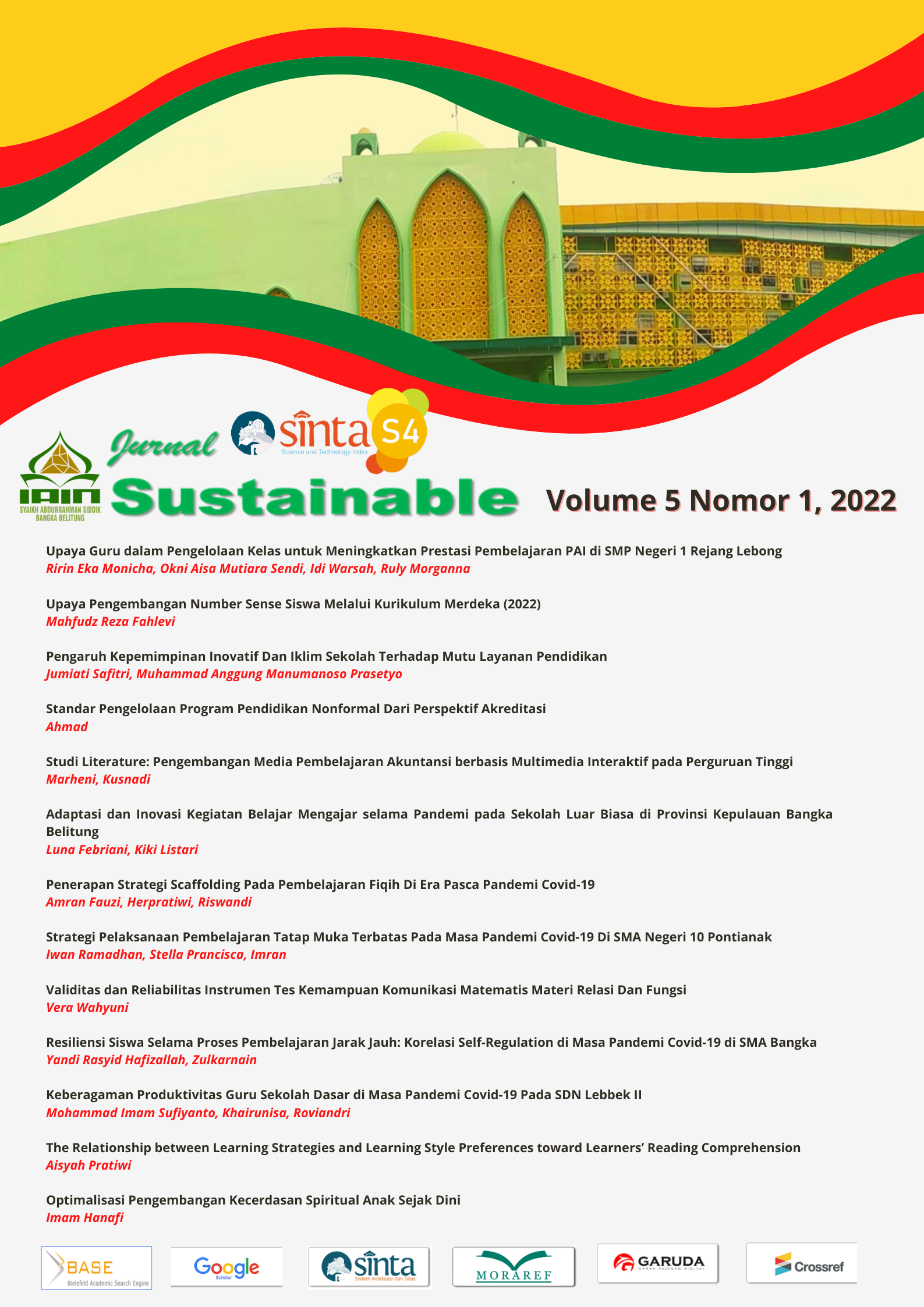The Relationship between Learning Strategies and Learning Style Preferences toward Learners’ Reading Comprehension
Abstract
objectives of this research are to find out: (1) the relationship between learning strategies and learning style preferences toward learners’ reading comprehension, (2) the relationship between learning strategies and learners’ reading comprehension and (3) the relationship between learning style preferences and learners’ reading comprehension. This was a correlational research which had been conducted at the twelfth graders of SMKN 6 Bekasi. Isaac and Michael table with 0.05 as the level of significant error was used as the way to determine the number of the sample. From the table, 161 learners became the The sample of this research with the use of simple random sampling as the way to choose the samples. Strategy Inventory of Language Learners (SILL) questionnaires, Perceptual Learning Style Preferences (PLSP) questionnaires and Indonesian National Examination were used as the instruments of this research. All of those instruments were tried out to obtain the valid and reliable items. Then, the data were analyzed using multiple regression. Based on the research result, the research findings were as follows: (1) there is significant relationship between learning strategies and learning style preferences toward learners’ reading comprehension; (2) there is significant relationship between learning strategies and reading comprehension; (3) there is no significant relationship between learning style preferences and reading comprehension. Finally, it can be inferred that (1) the combination of learning strategies and learning style preferences relate with learners’ reading comprehension; (2) learners’ reading comprehension does not significantly depend on learning style preferences but significantly depend on learning strategies.
Downloads
References
Al-Hebaishi, S. M. (2012). Investigating the Relationships between Learning Styles , Strategies and the Academic Performance of Saudi English Majors. International Interdisciplinary Journal of Education, 1(8), 510–520. https://doi.org/10.12816/0002890
Alharbi, M. A. (2015). Reading strategies, learning styles and reading comprehension: A correlation study. Journal of Language Teaching and Research, 6(6), 1257–1268. https://doi.org/10.17507/jltr.0606.13
Anderson, J. C. (2000). Assessing Reading. Cambridge University Press.
Baghban, Z. Z. V. (2012). The Relationship between Iranian English Language Learners’ Learning Styles and Strategies. Journal of Language Teaching and Research, 3(4). https://doi.org/10.4304/jltr.3.4.771-777
Celce-Murcia, M. (2001). Teaching English as a Second of Foreign Language (Third Edit). Heinle & Heinle.
Chavosh, M., & Davoudi, M. (2016). The Relationship between Perceptual Learning Styles and Reading Comprehension Performance of Iranian EFL Learners. International Journal of English Linguistics, 6(3), 61. https://doi.org/10.5539/ijel.v6n3p61
Cohen, A. D. (1999). Strategies in Learning and Using a Second Language. Addison Wesley Longman Limited.
Gebhard, J. G. (2000). Teaching English as a Foreign or Second Language: a Teacher Self-Development and Methodology Guide. University of Michigan Press.
Geoffrey Underwood and Vivienne Batt. (1996). Reading and Understanding: an Introduction to the Psychology of Reading. Blackwell Publishers Ltd.
J. Michael O’Malley and Anna Uhl Chamot. (1990). Learning Strategies in Second Language Acquisition. Cambridge University Press.
Khademi, M., Motallebzadeh, K., & Ashraf, H. (2013). The relationship between iranian EFL instructors’ understanding of learning styles and their students’ success in reading comprehension. English Language Teaching, 6(4), 134–142. https://doi.org/10.5539/elt.v6n4p134
Klingner, Janette K., S. V. and A. B. (2007). Teaching Reading Comprehension to Students with Learning Difficulties. The Guilford Press.
Leaver, Betty Lou, Madeline Ehrman, B. S. (2005). Achieving Success in Second Language Acquisition. Cambridge University Press.
Molla, B. (2015). The Relationship between Reading Strategy use and Reading Comprehension among Ethiopian EFL Learners. International Journal on Studies in English Language and Literature, 3(9), 34–41. www.arcjournals.org
Oxford, R. L. (1990). Language Learning Strategies: What Every Teacher Should Know. Newbury House Publishers.
Rasinski, D. B. and T. (2008). Comprehension That Works: Taking Students Beyond Ordinary Understanding to Deep Comprehension. Shell Education.
Reid, J. M. (1984). Perceptual learning style preference questionnaire. In Learning styles in the ESL/EFL classroom. https://fyse2015.files.wordpress.com/2015/09/perceptual_learning_style_preference_questionnaire.doc.
Rubin, D. (1982). A Practical Approach to Teaching Reading. CBS College Publishing.
Syllabus Class XII KI 4 Curriculum 2013. (n.d.).
Thompson, S. (2005). The Good Language Learners. TEFL/TESL Teaching Module 2. University of Birminham. https://www.birmingham.ac.uk/Documents/college-artslaw/cels/essays/secondlanguage/essayGLLSThompson.pdf
Zare, P., & Noordin, N. (2011). The Relationship between Language Learning Strategy Use and Reading Comprehension Achievement among Iranian Undergraduate EFL Learners. World Applied Sciences Journal, 13(8), 1870–1877. http://idosi.org/wasj/wasj13(8)/16.pdf
Copyright (c) 2022 Aisyah Pratiwi

This work is licensed under a Creative Commons Attribution 4.0 International License.






.png)
